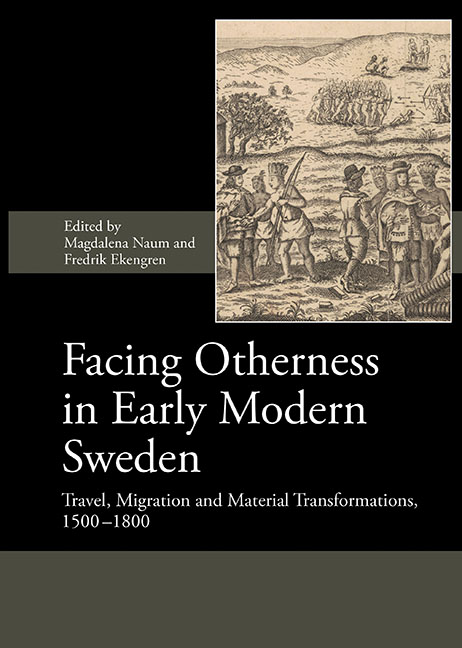Book contents
- Frontmatter
- Contents
- List of Illustrations
- List of Contributors
- Preface
- List of Abbreviations
- I Material Transformations
- Introduction
- 1 Tracing Other in 17th-Century Sweden
- 2 Houses of Wood, Houses of Stone: On Constructing a Modern Town in Early Modern Kalmar
- 3 Indigeneity, Locality, Modernity: Encounters and their Effects on Foodways in Early Modern Tornio
- 4 Brewing an Ethnic Identity: Local and Foreign Beer Brewing Traditions in 15th- to 17th-Century Sweden – an Example from Nya Lödöse
- 5 Tactile Relations: Material Entanglement between Sweden and its Colonies
- II Migration and Neighbourly Interactions
- III Overseas Travel
- IV Conclusions
- Index
1 - Tracing Other in 17th-Century Sweden
from I - Material Transformations
Published online by Cambridge University Press: 23 July 2019
- Frontmatter
- Contents
- List of Illustrations
- List of Contributors
- Preface
- List of Abbreviations
- I Material Transformations
- Introduction
- 1 Tracing Other in 17th-Century Sweden
- 2 Houses of Wood, Houses of Stone: On Constructing a Modern Town in Early Modern Kalmar
- 3 Indigeneity, Locality, Modernity: Encounters and their Effects on Foodways in Early Modern Tornio
- 4 Brewing an Ethnic Identity: Local and Foreign Beer Brewing Traditions in 15th- to 17th-Century Sweden – an Example from Nya Lödöse
- 5 Tactile Relations: Material Entanglement between Sweden and its Colonies
- II Migration and Neighbourly Interactions
- III Overseas Travel
- IV Conclusions
- Index
Summary
No single concept can convincingly describe 17th-century Sweden. We suggest an approach with focus on variability to get a better grip on the socio-economic processes, and search for new kinds of connections and relations, in which we address the other; the socially defined otherness; the ascribed otherness. But we also search for Other, alterity and difference as such, in the frame of the Swedish “heartland”. We focus mainly on the large variability in settlements, on ways of transforming settlements, on the making of new settlements and the ways of representing settlements.
Addressing the 17th century is no easy task. There are so many different kinds of society, of human (and, we must add, non-human) lives. The roles of European superpowers in this period were not straightforward, nor are they easy to comprehend. There has been and still is a tendency towards Eurocentric history writing, which makes us think from a European perspective. The violent history of the colonies in the Americas is a tragedy, and this traumatic experience is, most certainly, first and foremost the result of European expansion. But life in the Americas cannot, and this is important, be reduced to the European. The history of the Americas is far more complex and intricate, and we are only starting to grasp this interesting theme. Africa was violently tapped into via the slave trade during the same century, which also had a wide range of long-lasting effects. The 17th century is also marked by the fall, in 1644, of the Ming dynasty, a dynasty which had been powerful and influential far beyond the borders of China. The Moghuls still dominated much of south Asia. And along the eastern and southern borders of Europe this was a period in which the Ottoman Empire, although weakened, continued to play an important role. It was the time of the horrors of the Thirty Years’ War in which Europe became the scene of a destructive, partially anarchic and protracted era of violent conflict. This era of horror ended with the peace treaty at Westphalia, which established new political rules of lasting importance. The 17th century was also an era of technical developments, socio-economic change and fervent religious activities.
- Type
- Chapter
- Information
- Facing Otherness in Early Modern SwedenTravel, Migration and Material Transformations 1500–1800, pp. 5 - 26Publisher: Boydell & BrewerPrint publication year: 2018



